History
Boutwell was commissioned at Buffalo, New York on 29 October 1873. She was stationed temporarily at Ogdensburg, New York before being assigned a homeport on 11 September 1874 at Savannah, Georgia. On 18 February 1879 she was directed to make a monthly cruise to Jacksonville, Florida. On 27 August 1881 Boutwell was driven aground by a hurricane at McQueens Island on the Savannah River. [1] On 20 October 1882, the Revenue Cutter Service contracted with Malster & Reaney of Baltimore, Maryland to build a new boiler, repair machinery and hull for US$17,575 with work to commence 30 October 1882. She was ordered to return to Savannah after refit and arrived there 13 June 1883 to resume a regular cruising schedule to Jacksonville monthly. [1] With tensions between the Spanish and the U.S. rising over Cuban independence, Boutwell, USRC Colfax and USRC Windom were directed to enforce neutrality laws from Wilmington, North Carolina to Pensacola, Florida. She was ordered to serve with the U.S. Navy from 27 April to 1 June 1897. On 24 December she was ordered to Jacksonville to maintain surveillance over the tug Dauntless which had been seized by USRC Louis McLane for neutrality violations related to smuggling arms into Cuba. Dauntless had been seized with 175 rifles and 300,000 rounds of ammunition and medical supplies on board and Boutwell guarded her until 24 February 1898. [1] [4] On 24 September 1898, she was permanently assigned a new homeport at New Bern, North Carolina where she served until 3 July 1907. Boutwell was transferred to the Revenue Cutter Service Depot at Arundel Cove, Maryland where the commanding officer received orders to transfer the officers and crew to the newly built USRC Pamlico. Boutwell was decommissioned at Baltimore, Maryland, 26 July 1907 and sold to Leo Kimball of Mobile, Alabama for US$2,010 on 23 October 1907. [1] [2]

USS Bancroft was a United States Navy steel gunboat in commission from 1893 to 1898 and again from 1902 to 1905. She saw service during the Spanish–American War. After her U.S. Navy career, she was in commission in the United States Revenue Cutter Service from 1907 to 1915 as the revenue cutter USRC Itasca, and in the Revenue Cutter Service's successor service, the United States Coast Guard, as the cutter USCGC Itasca from 1915 to 1922. During her Coast Guard career, she saw service during World War I.
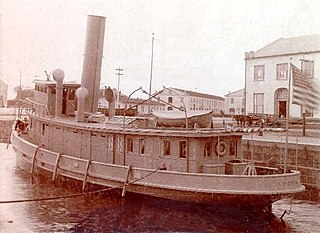
USRC Hudson, known for her service during the Battle of Cárdenas, was the United States Revenue Cutter Service's first vessel to have a steel hull and triple-expansion steam engine.
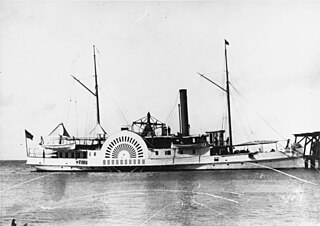
USS Delaware was a steamer acquired by the Union Navy for use during the American Civil War. She had a very active naval career as a gunboat for over three years, and after the war served as a revenue cutter for over 37 years. The steamer was sold to the private sector in 1903, and disappeared from shipping registers in 1919.
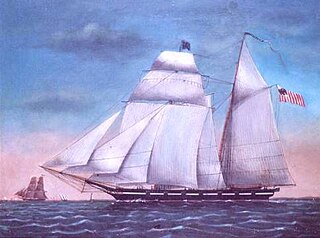
The United States Revenue Cutter Crawford was the first of the 13 cutters of the Morris-Taney Class to be launched. These cutters were the backbone of the U.S. Revenue Cutter Service for more than a decade. Samuel Humphreys designed these cutters for roles as diverse as fighting pirates, privateers, combating smugglers and operating with naval forces. He designed the vessels on a naval schooner concept. They had Baltimore Clipper lines. The vessels built by Webb and Allen, designed by Isaac Webb, resembled Humphreys' but had one less port

USRC Seminole was a 188 ft (57 m), 845-ton United States Revenue Cutter Service steamer constructed by the Columbian Iron Works in Baltimore, Maryland for $141,000. She was commissioned in 1900 and saw service through 1934, when she was transferred to the Federal Emergency Relief Administration.
USRC General Green was one of the first ten cutters operated by the U.S. Revenue Cutter Service. She was named for the Revolutionary War hero Major General Nathanael Greene. Her name was misspelled, probably by the man who oversaw her construction, the Collector of Customs in Philadelphia, Sharp Delany. Apparently the cutter was to have been originally named for the Secretary of the Treasury, Alexander Hamilton, but Delany changed the name for reasons unknown.

USRC Manning was a revenue cutter of the United States Revenue Cutter Service that served from 1898 to 1930, and saw service in the U.S. Navy in the Spanish–American War and World War I.

USRC Onondaga was an Algonquin-class cutter built for the U.S. Revenue Cutter Service for service on the Great Lakes. Because of the Spanish–American War, she was cut in half shortly before completion and transported to Ogdensburg, New York for service on the Atlantic coast although the war ended before she could be put into service. After the formation of the United States Coast Guard in 1915 she became USCGC Onondaga. She served as a patrol vessel at various Atlantic coast ports before World War I and unlike most Coast Guard cutters during World War I, she remained under the control of the Commandant of the Coast Guard. After the war she patrolled for a brief time based at New London, Connecticut before being decommissioned in 1923.

USRC Mohawk, was a steel steam powered revenue cutter built for the U.S. Revenue Cutter Service by William R. Trigg Company at Richmond, Virginia. Her primary duties in the Revenue Cutter Service and Coast Guard were assisting vessels in distress and enforcing navigational laws as well as a derelict destroyer. Mohawk was sunk after a collision with another vessel in October 1917.
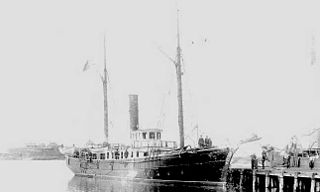
USRC Dexter was a Dexter-class cutter of the United States Revenue Cutter Service in commission from 1874 to 1908. She was the second ship of the Revenue Cutter Service to bear the name. The other Dexter-class cutters, all commissioned in 1874, were Dallas and Rush. Dexter was built by the Atlantic Works Company at Boston, Massachusetts. Captain John A. Henriques accepted her for service on 6 June 1874, and she was commissioned into the Revenue Cutter Service on 18 June 1874. Her role in the rescue of passengers from the sinking SS City of Columbus under winter gale winds brought her nationwide popular acclaim.

USRC Gallatin, was a Gallatin–class revenue cutter of the United States Revenue Cutter Service in commission from 1874 to 1892. The fourth ship of the Revenue Cutter Service to bear the name, she was named for the fourth U.S. Secretary of the Treasury, Albert Gallatin.
USRC Forward was a revenue cutter constructed for the U.S. Revenue Cutter Service in 1882 by Pusey & Jones shipyard in Wilmington, Delaware. She was the second Revenue Cutter Service vessel named Forward and was named for Walter Forward, the fifteenth United States Secretary of the Treasury. The iron-hulled vessel originally cost US$72,750 and was powered by a two-cylinder steam engine with a topsail schooner brigantine sail pattern. Although Forward was considered a model ship at the time of its construction, it was severely underpowered and had unreliable machinery. The cost of repairs in the first fifteen years of operation was US$52,000.

USRC Salmon P. Chase was named after Abraham Lincoln's Secretary of the Treasury, Salmon Portland Chase. It was a three-masted bark with a hull length of 106 feet that was designed for use as a training ship for the cadets of the Revenue Cutter Service School of Instruction.
USRC Wissahickon was one of two Winnisimmet-class harbor tugs constructed by Spedden Company for the Revenue Cutter Service. She was initially stationed at Philadelphia, Pennsylvania. Ellsworth P. Bertholf served as captain of her from 9 November 1906 to 20 September 1907 in his first tour as a commanding officer. Bertholf would later serve as the Commandant of the Coast Guard. After the U.S. Coast Guard was formed in 1915, she was known as USCGC Wissahickon. In 1916, she was transferred to Baltimore, Maryland. The Navy assumed control of her from 6 April 1917 to 28 August 1919 during World War I. On 1 January 1923 she was transferred from Baltimore to New York City, where she remained in service until being decommissioned on 8 May 1935. On 8 May 1935 Wissahickon was decommissioned and later sold.

USRC James C. Dobbin was a topsail schooner of the Cushing class (1853) named after President Franklin Pierce's Secretary of the Navy, James Cochrane Dobbin. She was initially stationed at Wilmington, North Carolina, but in 1856 was moved to Savannah, Georgia. She was seized by a secessionist mob on 3 January 1861 at Savannah and the officers and crew were held in irons. After the local customs inspector protested the seizure, Joseph E. Brown, the governor of Georgia ordered the cutter and crew released. Dobbin was the only revenue cutter based in the South to escape to the North before the Civil War. On 26 April 1861, she was ordered to Philadelphia, Pennsylvania to receive heavier armament and then assigned to New York City. In 1863 Dobbin was reassigned to Portland, Maine where she remained until being ordered to Baltimore, Maryland in December, 1876 to be refitted as a training ship. The first eight cadets of the newly established Revenue Cutter School of Instruction reported aboard Dobbin and they set sail on their first practice cruise on 24 May 1877. One of the eight cadets was future Commandant of the Coast Guard, Worth G. Ross. The following summer, she was replaced by the newly constructed training cutter USRC Salmon P. Chase and Dobbin returned to service as a revenue cutter until she was sold in 1881.
USRC Alabama, was a wood-hull topsail schooner designed by William Doughty that was commissioned in the United States Revenue Marine from 1819 to 1833. Assigned the homeport of Mobile, Alabama, she sailed the Caribbean extensively with her sister ship, USRC Louisiana and was used mainly in anti-piracy activity.

USRC Yamacraw, was a steel-hull flush-deck cutter that served in the United States Revenue Cutter Service from 1909 to 1937 and was the sister ship to the USRC Tahoma.
USRC Richard Rush was a Dexter-class cutter of the United States Revenue Cutter Service which served in the coastal waters of the western United States and the Department of Alaska.

USRC Pamlico was a revenue cutter of the United States Revenue Cutter Service that served from 1907 to 1946 designed specifically to cruise inland waters and did so while stationed at New Bern, North Carolina her entire career.
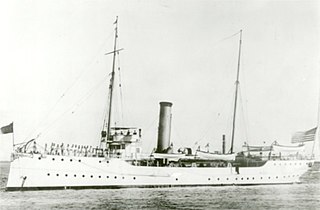
USRC Algonquin was an Algonquin-class cutter built for the U.S. Revenue Cutter Service for service on the Great Lakes. Because of the Spanish–American War, she was cut in half shortly before completion and transported to Ogdensburg, New York for service on the Atlantic coast although the war ended before she could be put into service. She was homeported at San Juan, Puerto Rico from 1905 to 1917. Algonquin served briefly for the U.S. Navy along the Atlantic Coast in the summer of 1898 before being returned to the Treasury Department. After the formation of the United States Coast Guard in 1915 the vessel became USCGC Algonquin. The ship served as a patrol vessel at Norfolk, Virginia at the beginning of World War I before being assigned convoy duty in the Mediterranean. In February 1919 Algonquin was transferred to the West Coast and served in the Pacific Northwest and Alaska until being decommissioned at San Francisco in December 1930.















